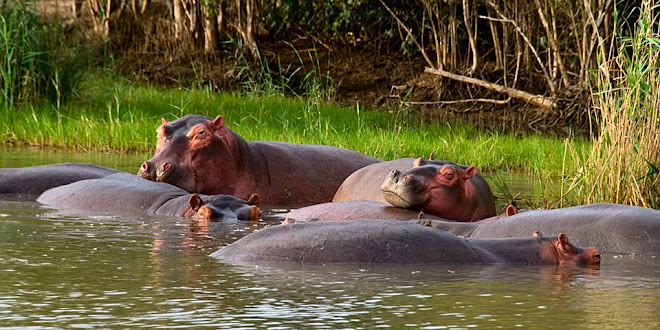The next day, we drove into the nearby Royal Natal National Park, part of the uKhahlamba / Drakensberg Park World Heritage Site, where we did a series of hikes throughout the day. The first hike was an hour long: we climbed a hillside to an overhanging cliff that protected a group of 800-year-old Bushmen paintings. The Bushmen civilization has existed in the Drakensberg for at least 40,000 years. High up in the sedimentary rock that formed the cliff were some starfish fossils, indicating that this high elevation was under the sea millions of years ago.

The destination of the second hike was the Cascades, and the easy trail had a view of the Drakensberg Amphitheatre to one side. Hidden somewhere in the shadows of this towering bluff was Tugela Falls, the second highest waterfall on Earth after Venezuela's Angel Falls. The sheer cliffs on either side of Tugela drop 3,000 feet to the ground. Unfortunately, we would not see the waterfall because it requires an eight-hour hike to get there. It only took half an hour to get to the Cascades, a beautiful series of drops ending in a deep pool in the middle of the forest. As we sat on the rocks with our feet in the cold water, some baboons appeared at the top of the falls and started making their way down towards us. I didn't even have time to put on my shoes before we retreated to safety – baboons have no fear of people and can be quite dangerous if you have food. I didn't have food in my pack, but some of the others did. The baboons stayed away from us, but they cornered two older women who were picnicking on the rocks. Eventually they scattered and left the women alone.
We got back to the truck after a short hike through the forest, and lunch was ready and waiting for us. After eating our sandwiches, we embarked on a long afternoon hike to Sunday Falls. We crossed vast fields of tall grass that blanketed the hilly landscape and had scenic views of the majestic mountains in the distance. We saw a few antelopes in the distance, and one woman saw a small snake slithering into the grass as we passed. After an hour, we reached the waterfall, which flowed into a lush forested gorge cutting between two grassy hills. It was impossible to get to the bottom of the gorge to see the falls from below, and the view from the top was uninspiring. We took a break by the stream at the top of the waterfall and then commenced the hour-long hike back to the truck.
Yesterday, it was three and a half hours to Durban, South Africa's third largest city and the busiest port in all of Africa. Durban sits on the Indian Ocean and is normally a great beach location, but it was pouring down rain when we arrived. Most of us spent the afternoon relaxing around the hostel – there is not much to do in the city anyway. The rain let up by dinnertime, and we went out to a seafood restaurant as a farewell dinner for the two passengers who were ending their trip in Durban.
This morning, we picked up eight new passengers, which increased our group size to fifteen. There are seven of us who have been on the trip since Cape Town. The new passengers also diversified the make-up of our mostly Dutch group: we gained an American girl, a British guy, a Canadian guy, a German girl, a Kiwi couple, and two more Dutch guys. We drove three hours to St. Lucia, also on the coast, where we embarked on a game cruise after lunch at the campsite. The cruise was on Lake St. Lucia within the World Heritage Site of iSimangaliso Wetland Park. We saw quite a few Nile crocodiles, a variety of birds, and tons of hippos.
After the cruise, we returned to the campsite and watched a Zulu dance around the fire. The moves were extremely powerful – the dancers lifted their legs high into the air and then slammed their feet onto the ground as hard as they could. I could feel the vibrations through the hard earth from twenty feet away. After the dance, we ate dinner and went straight to bed; we have to rise very early tomorrow morning for a game drive.





No comments:
Post a Comment